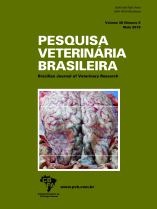 |
|
|
|
Year 2018 - Volume 38, Number 5
|

|
Isolation and enzymatic profile of dogs and cats with dermatofitosis attended at veterinary hospitals in Recife, Pernambuco, Brazil, 38(5):930-934
|
ABSTRACT.- Torres M.E.L.M., Herculano P.N., Lima M.L.F., Soares P.T., Siqueira A.B.S., Souza‑Motta C.M., Porto A.L.F. & Nascimento C.O. 2018. [Isolation and enzymatic profile of dogs and cats with dermatofitosis attended at veterinary hospitals in Recife, Pernambuco, Brazil.] Isolamento e perfil enzimático de cães e gatos com dermatofitose atendidos em hospitais veterinários do Recife, Pernambuco. Pesquisa Veterinária Brasileira 38(5):930-934. Laboratório de Tecnologia de Bioativos, Departamento de Morfologia e Fisiologia Animal, Universidade Federal Rural de Pernambuco, Rua Dom Manoel de Medeiros s/n, Dois Irmãos, Recife, PE 52171-900, Brazil. E-mail: cynthiaonbm@yahoo.com.br
Dermatophytes are fungi that can cause superficial infections of the skin, hair and nails in man and animals. The most frequent dermatophyte species isolated from dogs and cats are Microsporum gypseum, most notably Microsporum canis. The crucial role during the infection process is the production of extracellular enzymes essential for the invasion and establishment of the pathogen in the host tissue. The objective of this research was to isolate dermatophytes from dogs and cats and evaluate the enzymatic profile of the isolates obtained. Hair samples and epidermal scales were collected from dogs and cats in veterinary facilities in Recife-PE, and the isolates were identified based on macroscopic and microscopic characteristics. The qualitative analysis of the enzymes urease, protease, lipase, collagenase and phospholipase was evaluated from the isolated dermatophytes. During 10 months, a total of 106 animals, comprising of 99 dogs and seven cats with clinical signs, regardless of sex and race were evaluated. Only eight animals were confirmed with dermatophytosis, mostly dogs (n=7), being six affected by M. canis and one by M. gypseum, the race most affected was Yorkshire (n=3). However, only one cat was confirmed with M. canis. No sex‑related predisposition was observed regarding the occurrence of dermatophytosis in dogs and cats evaluated. Isolated dermatophytes showed similar profiles for the enzymes urease, lipase, protease, phospholipase and collagenase, important characteristic for pathogenic infections. The diagnosis of this zoonosis based on microbiological confirmation and a better understanding of the underlying mechanisms is of great importance for the treatment and prevention of fungal diseases in animals. |
| |
|
|
| |
|
 |